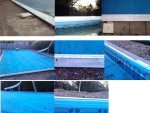I disagree with you bk406. I highly doubt your New England winter is any worse than the freeze thaw cycle in the upper midwest. Second, putting CA6 (gravel with fines which you describe) to backfill around a pool is asking for trouble. CA6 does not drain well and is typically wetted and compacted 1-2 inches at a time to build up a 12-18 inch base below the packed sand bed the pavers lay on. When doing a steel wall pool the over dig for the bond beam should be filled with washed stone or pea gravel for drainage, not CA6. Anytime you put packed CA6 on top of washed or pea gravel the fines and sand will start to work its way into the voids over time if water is present. This is both bad for drainage and can cause the base to settle in such a wet environment like a pool deck. Even with polymeric sand to fill the voids, there's plenty of water that gets beneath the pavers.
Adding any type of soil during the packing cycle can create an expansive fill, not good.
I challenge you to take a good paver/brick glue and glue two pavers together. Then do the same with mortar. More times than not when you break the pavers apart, the mortar will split at the cold joint with no damage to the paver while the glued bricks will actually tear a chunk out of the concrete paver.
Look at the pictures above and those bricks look exactly the same three seasons later. Nothing loose, nothing settled.
To NullQwerty's questions:
1) Yes, vinyl liner pool.
2) The cantilevered pavers are glued to each brick next to it and behind it, but only the first row behind coping pavers.
3) No expansion joint was used. There are enough voids between all the bricks as a whole and a slight flex in the aluminum autocover track that there aren't any problems with the pavers or autocover. The packed sand bed comes up to the same level as the autocover track.
4) To be honest, I don't remember which glue. My brother owns the landscaping company so it was whichever glue they were using at the time. I know they have changed glue a couple of times over the years. For a long period they were using Liquid Nails Heavy Duty until the formula changed. It was outperforming some very expensive landscaping glue.
5) See the poured bullnose coping picture on this page:
http://www.coverstar.com/SwimmingPoolCo ... gular.aspx. Instead of pouring concrete, pavers were used.
6) Gluing was absolutely easier and looked better. Using the autocover track encapsulation as a screed guide for the sand, made it perfect. Obviously the base and sand needed to be packed so they don't settle. Gluing the pavers together provides tremendous strength without putting any undue pressure on a single point on the track encapsulation.
Don't go with the cheapest bidder for the stone work. Proper base installation is the biggest key to long term stability.


